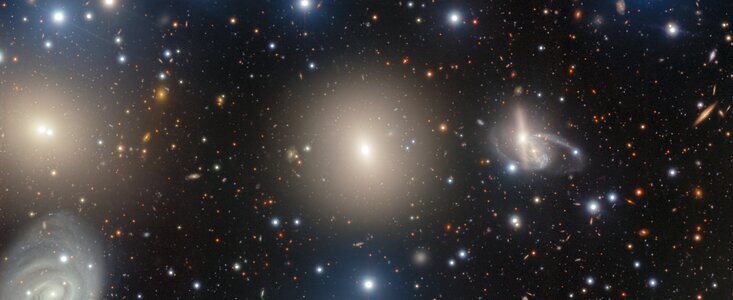29.10.2024
One century after astronomers proved the existence of galaxies beyond the Milky Way, enormous galaxy clusters are offering clues to today’s cosmic questions

100 years ago Edwin Hubble discovered decisive evidence that other galaxies existed far beyond the Milky Way. This image, captured by the Gemini North telescope, one half of the International Gemini Observatory, features a portion of the enormous Perseus Cluster, showcasing its ‘island Universes’ in awe-inspiring detail. Observations of these objects continue to shed light not only on their individual characteristics, but also on cosmic mysteries such as dark matter.
Among the many views of the Universe that modern telescopes offer, some of the most breathtaking are images like this. Dotted with countless galaxies — each one of incomprehensible size — they make apparent the tremendous scale and richness of the cosmos. Taking center stage here, beguiling in its seeming simplicity, the elliptical galaxy NGC 1270 radiates an ethereal glow into the surrounding darkness. And although it may seem like an island adrift in the deep ocean of space, this object is part of something much larger than itself.
NGC 1270 is just one member of the Perseus Cluster, a group of thousands of galaxies that lies around 240 million light-years from Earth in the constellation Perseus. This image, taken with the Gemini Multi-Object Spectrograph (GMOS) on the Gemini North telescope, one half of the International Gemini Observatory — supported in part by the U.S. National Science Foundation and operated by NSF NOIRLab — captures a dazzling collection of galaxies in the central region of this enormous cluster.
Looking at such a diverse array, shown here in spectacular clarity, it’s astonishing to think that when NGC 1270 was first discovered in 1863 it was not widely accepted that other galaxies even existed. Many of the objects that are now known to be galaxies were initially described as nebulae, owing to their cloudy, amorphous appearance. The idea that they are entities of a similar size to our own Milky Way, or ‘island Universes’ as Immanuel Kant called them, was speculated on by several astronomers throughout history, but was not proven. Instead, many thought they were smaller objects on the outskirts of the Milky Way, which many believed to comprise most or all of the Universe.
The nature of these mysterious objects and the size of the Universe were the subjects of astronomy’s famous Great Debate, held in 1920 between astronomers Heber Curtis and Harlow Shapley. The debate remained unsettled until 1924 when Edwin Hubble, using the Hooker Telescope at Mount Wilson Observatory, observed stars within some of the nebulae to calculate how far they were from Earth. The results were decisive; they were far beyond the Milky Way. Astronomers’ notion of the cosmos underwent a dramatic shift, now populated with innumerable strange, far-off galaxies as large and complex as our own.
As imaging techniques have improved, piercing ever more deeply into space, astronomers have been able to look closer and closer at these ‘island Universes’ to deduce what they might be like. For instance, researchers have observed powerful electromagnetic energy emanating from the heart of NGC 1270, suggesting that it harbors a frantically feeding supermassive black hole. This characteristic is seen in around 10% of galaxies and is detectable via the presence of an accretion disk — an intense vortex of matter swirling around and gradually being devoured by the central black hole.
It’s not only the individual galaxies that astronomers are interested in; hints at many ongoing mysteries lie in their relationship to and interactions with one another. For example, the fact that huge groups like the Perseus Cluster exist at all points to the presence of the enigmatic substance we call dark matter [1]. If there were no such invisible, gravitationally interactive material, then astronomers believe galaxies would be spread more or less evenly across space rather than collecting into densely populated clusters. Current theories suggest that an invisible web of dark matter draws galaxies together at the intersections between its colossal tendrils, where its gravitational pull is strongest.
Although dark matter is invoked to explain observed cosmic structures, the nature of the substance itself remains elusive. As we look at images like this one, and consider the strides made in our understanding over the past century, we can sense a tantalizing hint of just how much more might be discovered in the decades to come. Perhaps hidden in images like this are clues to the next big breakthrough. How much more will we know about our Universe in another century?
Quelle: NSF NOIRLab (U.S. National Science Foundation National Optical-Infrared Astronomy Research Laboratory)
